The investigator who put the Gladiator behind bars
The young skinhead tried to explain to the stern sergeant at the South Melbourne station that looks can be deceiving.
He and a few of his gang were hauled in for kicking over rubbish bins, hooning around and apparently looking for trouble. By way of explanation the young man said they were not bash artists but dramatic artists - actors playing neo-Nazi skinheads in a cutting-edge movie.
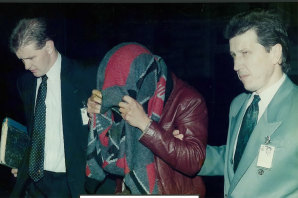
Senior Detective Phil Shepherd and Detective Mick Hughes (right) flank Wei Yin Chan, who was convicted of the murder of eight-year-old Kylie Gill.
The budding actor would later recall the sergeant seemed unimpressed, responding: “Is that right? Well, I hope you’re a method actor, son, because you’re really going to enjoy this. Put him in the f---ing cell.â€
“At the time, I was really kind of angry,†the actor recalls. “But over time you cannot help but laugh at that. That’s funny as hell.â€
Nearly 30 years later, the man who was that sergeant denies using such rude language but acknowledges the young man was given four hours in the cells to reflect on both his acting methods and street behaviour. “Actually, he didn’t seem a bad bloke.â€
It turned out the prisoner was telling the truth. He was in the movie Romper Stomper.
The Gladiator and the Investigator both kicked on: the sergeant, Mick Hughes, would become the 29th head of the homicide squad and the actor, Russell Crowe, graduated to Hollywood.
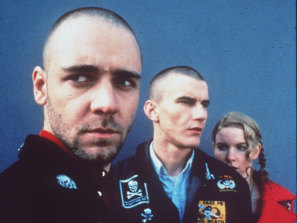
Russell Crowe (left) in a cast shot for the movie Romper Stomper.Credit:
After 43 years Hughes has just retired from what he says is “the best job in the worldâ€. But it has come at a cost.
Hughes followed the family tradition, joining the army and after 10 years - seven of them as a military policeman - joining the Victoria Police.
A missing person’s case that turned into a murder gave him a taste for homicide investigations. Insurance broker Jimmy Pinakos went missing in April 1989 and Hughes was convinced he had been murdered. Associate Ron Lucas was also missing, either because he was on the run or had also been killed.
Three months later Pinakos’ dismembered body was found packaged in two shallow graves at Rye. He had been shot in the heart with a crossbow. Lucas was arrested in Adelaide wearing some of Pinakos’ jewellery. He was convicted of the murder.
Hughes joined the Homicide Squad in 1992, working under legendary Senior Sergeant Rod Wilson. “Rod was a great boss who taught me what I call humane leadership. He had great interpersonal skills.â€
He quickly learned that murderers can’t be typecast: “So many killers are not the face of evil that you expect. They can be quite unremarkable.â€
One of his first jobs was a double murder in Kinglake. Career criminal John Lindrea was invited to a housewarming party for Kayleen McDonald, the widowed mother of three. When he was asked to leave, he went to a car, returned with a gun and opened fire, killing McDonald, guest Andrew Johns and wounding a third man.
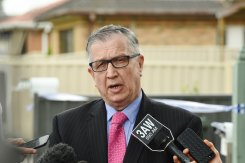
Mick Hughes briefs the media at a murder scene.Credit:Justin McManus
We see stern-faced Homicide Squad detectives on the TV news walking into crime scenes, carrying official- looking folders, conducting doorstop interviews â€" impressive, impassive and ice cool.
Often it is a professional mask. For Hughes it was an early morning call on an unseasonably cold December morning that still affects him. As he recalls that night, his voice wavers and his eyes glisten. There are some memories that never dim.
He had been called to the suspected hit-run death of eight-year-old Kylie Gill. Hughes quickly realised it was murder. “It was a bitterly cold night and she was wearing no slippers and only pink flannelette pyjamas. Her mother [Mary, who was confined to a wheelchair] told us Kylie was afraid of the dark. We knew she hadn’t wandered or run away.â€
As a father of young kids it hit him hard. “She was a beautiful little girl.â€
In those days you didn’t show your emotions, just kept your game face on and solved the crime. They caught the killer, who was sentenced to 25 years with a minimum of 15.
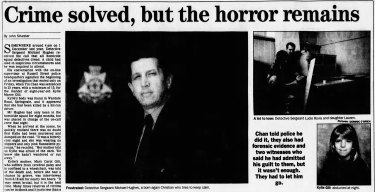
Coverage of the Kylie Gill case in The Age, August 1993.Credit:Age archives
Nearly 30 years after he arrived at the Springvale crime scene, Hughes now knows he never really left. It is called Compound PTSD, brought on not by one traumatising episode but dozens or perhaps hundreds. “It was explained to me as each incident is a book that you carefully put on the shelf until there are so many that the bookcase collapses,†he says.
That would come, but back then there were killers to catch â€" and none worse than Frankston serial killer Paul Charles Denyer, who in the winter of 1993 killed three women and stalked many more.
After the second fatal attack the head of homicide, Detective Chief Inspector Peter Halloran, knew they were hunting a serial killer who would continue to murder until caught. He assigned crew seven under Rod Wilson as the lead investigation team.
Denyer always struck when it rained, hoping it would wash away forensic clues. And it was a wet winter.
Homicide detectives are trained to be meticulous and travel slowly, with a successful prosecution at the Supreme Court the ultimate goal. This time it was different. The need to identify and arrest was urgent because every time it rained there was a chance someone would die.
“We knew if we didn’t get him he would strike again,†says Hughes.
Elizabeth Stevens, 18, a student, was stalked and killed on June 11, and Debra Fream, 22, a young mother, was abducted and murdered on July 8.
On Friday, July 30, the 10 key investigators met to review Operation Reassurance â€" a massive doorknock planned for the next day. As they talked tactics it began to rain â€" heavily.
Around the time police were meeting, 21-year-old Denyer drove a short distance from his Frankston home to Skye Road and cut three holes in a cyclone fence next to a bike track near John Paul College, a local secondary school. His aim was to ambush his victim and drag her into thick scrub, away from potential witnesses.
As he sat in his car Natalie Russell, 17, a John Paul student, walked past heading down the bike track as a short cut home. Denyer followed and stabbed her to death.
An alert postie saw a man in a car who seemed to slump down to avoid being seen and she reported her suspicions. Two police units were dispatched and logged Denyer’s now empty car.
When Russell’s body was discovered, police computer checks showed Denyer’s car at the scene of the murder. Further checks revealed Denyer had lived in Long Street, the street where Elizabeth Stevens was grabbed.
Using Operation Reassurance as a cover, police went to Denyer’s home. He was out and they left a card asking to make contact. He did.
Denyer was enthusiastically co-operative and he remembered his exact movements at the time of the murders. “His answers were just too neat,†says Hughes.
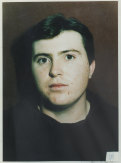
Serial killer Paul Charles Denyer.
Wilson asked Hughes: “What do you think?â€
“He’s our man,†came the reply.
They found Denyer’s runners sitting on the bar heater in a bid to alter the sole tread, a homemade knife and suspicious cuts on his hands.
During the interview Wilson adopted a courteous, almost friendly approach. Meanwhile the pathologist found a piece of skin in his last victim’s throat that came from Denyer’s hand.
When Wilson raised the evidence Denyer tried to explain but eventually confessed. “The interview was a work of art,†says Hughes.
Hughes moved out of the squad, returning twice â€" once to run a crew and then, in 2014, as head of the squad. “It was a fantastic job. It was like being the coach of the best team in the AFL.â€
Always concerned about the welfare of his team, he ignored his own gathering clouds. He was tired, had broken sleep but put it down to the pressures of the job. When a receptionist asked “Boss, are you OK?†he brushed off her concerns. “She knew something was wrong. I didn’t.â€
Hughes was considering retiring at the end of his stint at homicide. Instead in 2017 he was called in and told he had no choice - he was to be transferred.
Feeling abandoned and betrayed, he took six months off for an overseas trip, spending most of it feeling dispirited and ill. He wanted to return to work only to be told: “Mick, you are too angry to come back, you need assistance.â€
“I thought they were trying to get rid of me.â€
He was angry, depressed, couldn’t sleep and suffered flashbacks. He sought help and was diagnosed with PTSD: “That was the first step in recovery. Then you can do something about it.â€
At one point his counsellor asked him to rate his tolerance levels. He gave himself a rating of 5 out of 10. He went home and asked his wife Sue to rate him: “She said I [didn’t score] 1.â€
It was a long way back but Hughes is in a good space. He has lost 20 kilos and walks eight kilometres a day. “I’m fitter physically and emotionally than I have been for 10 years.â€
There is an expression in policing he hates: “There is nothing more ex than an ex.†He says it is vital for former police to be valued for their contributions and to remain connected. He urges his colleagues to reach out to old mates who may be struggling: “It can make all the difference.â€
John Silvester is a columnist.
0 Response to "The investigator who put the Gladiator behind bars"
Post a Comment